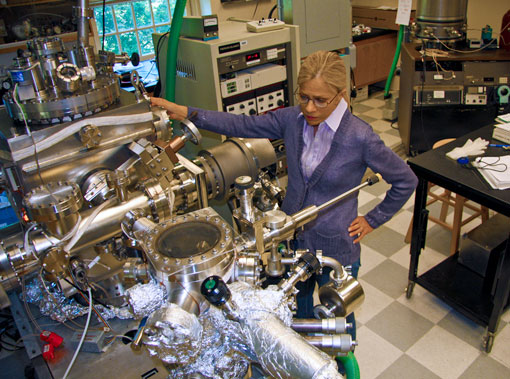Building a better bomb sniffer
A William & Mary/JLab team takes a basic-science approach to a more secure homeland
A team of scientists led by a professor at William & Mary has been tapped by a U.S. government agency to pursue an avenue of scientific inquiry that is expected to lead to the development of a new line of devices to detect weapons of mass destruction.
The Defense Threat Reduction Agency (DTRA) is funding the five-year project headed by R.A. Lukaszew, VMEC Associate Professor in William & Mary’s departments of physics and applied science. Lukaszew and her group will receive a total of $1.75 million to investigate the use of superconducting thin films to improve the efficiency of high-energy linear accelerators, also known as linacs. The DTRA project will also involve researchers at the Thomas Jefferson National Accelerator Facility (JLab) in Newport News.
Lukaszew explained that DTRA’s interest in a more efficient linac stems from the agency’s need for a device to detect fissile materials at long range. The ultimate goal is for a small, portable device capable of identifying the atomic “fingerprint” of a nuclear bomb or the materials used in the construction of such devices from a distance around 1,000 meters.
Mark Hinders, chair of William & Mary’s applied science department, says that a “bomb-sniffing” linac would be an extremely valuable addition to the Homeland Security defense arsenal, particularly in Hampton Roads. “Something like this could be used for detecting dirty bombs or hidden nukes in checkpoint-type situations,” Hinders said. “At a place like the Port of Hampton Roads, there’s a lot of interest in being able to tell if bad guys are trying to bring something through that they shouldn’t.”
Linacs work by generating a beam of subatomic particles, then accelerating the particles by applying an electromagnetic field as they move down the linac’s cavity. One class of linac uses superconducting radio frequency (SRF) technology.
“By cooling the linac down below the temperature at which it starts being a superconductor, you can apply very large radio frequency fields and this material will be able to perform its task efficiently,” Lukaszew said. The performance of SRF linacs has approached its theoretical limits, she says—a problem arising from the intrinsic qualities of niobium, the metal used to construct the superconducting linac cavity. There are also other challenges associated with niobium, including heat transfer and the fact that bulk niobium is expensive, which can make fabrication and operation more challenging.
Lukaszew and her group are charged with investigating the possibility of making linac cavity more efficient through the development and use of a multilayered thin-film coating on top of a metal substrate. Thin-film solutions may address many of the limitations inherent in SRF cavities crafted only from niobium.
“Copper, for example, is a good material in terms of heat transport, machinability and costs and so forth,” she explained. “Our idea is to investigate coating the interior part of the cavity with niobium, a niobium composite or another type of superconducting materials that in thin-film form can accomplish the task with better performance.”
Lukaszew and her group will work to model, test and develop thin-film approaches to the problem of engineering a more efficient device. A more efficient linac, she explained, is one capable of sustaining a higher field gradient.
“The idea for defense is that they want to have a material that can sustain field gradient considerably higher than niobium—twice as much as the theoretical limit,” she said. “In that way they can reduce the size of this accelerator substantially and to make them more portable for the detection of fissile materials.”
She will be joined in her research by scientists at JLab, including Charles Reece, who is a senior staff scientist and deputy director at the JLab’s Institute for SRF Science and Technology. She said JLab has its own interests in developing a more efficient linac.
“For them, portability’s not the main issue,” Lukaszew said. “They are really concerned with pushing the field gradient to the highest that can be done. Achieving a material that’s more efficient is definite an advantage either for a research or defense purpose.”
She said that work on the project will be divided between the facilities at JLab and her own labs at William & Mary. Her team will also include William & Mary graduate student Douglas Beringer and several others. 
















